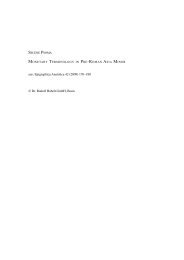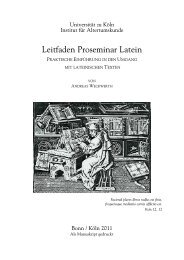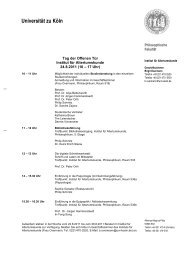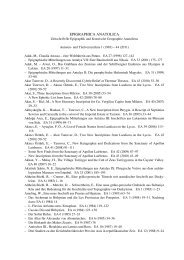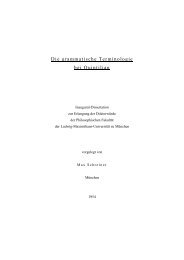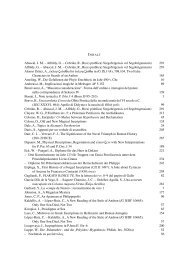ZPE Inhalt Bände 101ff. - Institut für Altertumskunde - Universität zu ...
ZPE Inhalt Bände 101ff. - Institut für Altertumskunde - Universität zu ...
ZPE Inhalt Bände 101ff. - Institut für Altertumskunde - Universität zu ...
Create successful ePaper yourself
Turn your PDF publications into a flip-book with our unique Google optimized e-Paper software.
Autoren- und Titelverzeichnis <strong>ZPE</strong> 101 ff. 49<br />
ROXAN, M. M. – PAUNOV, E. I., The Earliest Extant Diploma of Thrace, A. D. 114 (= RMD I 14). 119 (1997) 269–279<br />
ROY, J., “The Arkadians” in Inschriften von Magnesia 38. 145 (2003) 123–130<br />
–, Elean Voting-tokens and Courts at Psophis in the Later Third Century. 156 (2006) 129–130<br />
–, Homonoia in Inschriften von Olympia 260: the Problem of Dating Concord in Elis. 167 (2008) 67–72<br />
ROZOKOKI, A., Some New Thoughts on Stesichorus’ Geryoneis. 168 (2009) 3–18<br />
RUBINSTEIN, L. – LA’DA, C., Greek Ostraca from Pselkis. 110 (1996) 135–155<br />
RUCK, B., Die Fasten von Taormina. 111 (1996) 271–280<br />
RUDHARDT, J. – HURST, A., Stellungnahme. 103 (1994) 154<br />
RUFFINI, G. R., The Commonality of Rare Names in Byzantine Egypt. 158 (2006) 213–225<br />
–, Psalms 149–150: A Bilingual Greek and Old Nubian Version from Qasr Ibrim. 168 (2009) 112–122<br />
–, Nubian Ostraka from the West Bank Survey. 175 (2010) 231–238<br />
RUFFINI, G. R. – BAGNALL, R. S., Civic Life in Fourth-Century Trimithis. Two Ostraka From the 2004 Excavations. 149 (2004) 143–152<br />
RUGGERI, Cl., Note sulle divergenze nel dialetto e nella forma delle lettere tra le iscrizioni del centro-sud della Trifilia e quelle dell’Elide. 133 (2000)<br />
117–121<br />
–, Menone, figlio di Menecleide, ateniese, del demo di Gargetto. 138 (2002) 73–86<br />
RUGGERI, P., Un signifer della Cohors Ligurum in Sardegna. 101 (1994) 193–196<br />
RUIZ VALDERAS, E. – GOROSTIDI PI, D., Un nuevo aedilis lustralis procedente de Tusculum (Lacio, Italia). 178 (2011) 273–278<br />
RÜPKE, J., Fehler und Fehlinterpretationen in der Datierung des dies natalis des stadtrömischen Mater Magna-Tempels. 102 (1994) 237–240<br />
–, Iuno Sospita oder Victoria Virgo? Zur Identifizierung des sogenannten Auguratoriums auf dem Palatin. 108 (1995) 119–122<br />
RUSCU, L., Actia Nicopolis. 157 (2006) 247–255<br />
RUSJAEVA, A. S. – VINOGRADOV, J., Phantasmomagica Olbiopolitana. 121 (1998) 153–164<br />
RUSSEL, Th., ‘The Land of Inachus’ – Byzantium’s Early Coinage and Two Bosporus Toponyms. 180 (2012) 133–138<br />
RUSSO, S., Note e correzioni a papiri documentari. 155 (2006) 191–199<br />
RUSTEN, J., The Four “New Lenaean Victors” of 428–5 B.C. (and the Date of the First Lenaean Comedy) Reconsidered. 157 (2006) 22–26<br />
RUTGERS, L. V., Interaction and its Limits: Some Notes on the Jews of Sicily in Late Antiquity. 115 (1997) 245–256<br />
RUTHERFORD, I., The Nightingale’s Refrain: P. Oxy. 2625 = SLG 460. 107 (1995) 39–43<br />
–, Et Hominum Et Deorum . . . Laudes (?): A Hypothesis about the Organisation of Pindar’s Paean-Book. 107 (1995) 44–52<br />
–, Pindarus Armenicus: Paean, IX 1–10 as transmitted in Philo, De Prov. 2.80 (97 Aucher). 112 (1996) 37–46<br />
–, Kalasiris and Setne Khamwas: A Greek Novel and some Egyptian Models. 117 (1997) 203–209<br />
–, For the Aeginetans to Aiakos a Prosodion: An Unnoticed Title at Pindar, Paean 6, 123, and its Significance for the Poem. 118 (1997) 1–21<br />
–, The Amphikleidai of Sicilian Naxos: Pilgrimage and Genos in the Temple Inventories of Delos. 122 (1998) 81–89<br />
–, pros≈idion. A Musical Term in a Delian Inscription (IG XI 120.49). 130 (2000) 147–148<br />
–, The Reader’s Voice in a Horoscope from Abydos (Perdrizet and Lefebvre, n. 641). 130 (2000) 149–150<br />
–, Paeans at Ptolemais? 135 (2001) 41–42<br />
–, The Keian Theoria to Delphi: Neglected Data from the Accounts of the Delphic Naopoioi (CID 2.1–28). 147 (2004) 107–114<br />
RYAN, F. X., Two Senators in 73 B.C. 108 (1995) 306–308<br />
–, Three More Senators in 73 B.C. 153 (2005) 269–270<br />
–, Whether Livius or Others Wrote princeps in senatu with lectus. 173 (2010) 245–252<br />
RYHOLT, K., A Demotic Version of Nectanebos’ Dream (P. Carlsberg 562). 122 (1998) 197–200<br />
RZEPKA, J., Amnestia for Eurydamas of Phthiotic Thebes? A New Interpretation of SEG 53, 565. 172 (2010) 87–92<br />
RZEPKA, J. – JUHEL, P. – NOGUERA BOREL, A. – SEKUNDA, N. V., A New Greek Inscription from the Area of Tremnik (Republic of<br />
Macedonia/Skopje). 161 (2007) 170–172<br />
SACCO, G., Due nuove iscrizioni latine di interesse onomastico (Altera, Cenebes). 126 (1999) 269–274<br />
–, G∞w pa›w efimi. Sul v. 10 della laminetta di Hipponion. 137 (2001) 27–33<br />
SADDINGTON, D. B., A Context for a Dedication by Five Cavalry Regiments to a Cornelius Scipio in Rome? 104 (1994) 73–77<br />
–, An Ala Tungrorum? 138 (2002) 273–274<br />
–, A Possible Context for the Definitive Establishment of the Classes Perinthia and Pontica. 175 (2010) 239–240<br />
SÄNGER, P., Saralaneozan und die Verwaltung Ägyptens unter den Sassaniden. 164 (2008) 191–201<br />
–, Die Nomenklatur der legio II Traiana Fortis im 3. Jh. n. Chr. 169 (2009) 277–286<br />
–, Σιρωτής: ein papyrologisches „ghost-word“. 173 (2010) 208–210<br />
SÄNGER-BÖHM, K., Die συντάξεις und τέλη τὰ ἐπὶ ταῖς ταφαῖς in der Hadriansinschrift aus Alexandria Troas: Eine papyrologische<br />
Bestandsaufnahme. 175 (2010) 167–170<br />
SÁEZ FERNÁNDEZ, P. – ORDÓÑEZ AGULLA, S. – SAQUETE CHAMIZO, J. C. – GARCÍA-DILS DE LA VEGA, S., Hispania Baetica, provincia<br />
immunis. 154 (2005) 299–311<br />
SAKURAI, M., A New Reading in POxy. XIII 1606 (Lysias, Against Hippotherses). 109 (1995) 177–180<br />
SALAMA, P., Anomalies et aberrations rencontrées sur des inscriptions milliaires de la voie romaine Ammaedara – Capsa – Tacapes. 149 (2004) 245–<br />
255<br />
v. SALDERN, F., Einige Bemerkungen <strong>zu</strong>r Kalenderreform des Commodus. 146 (2004) 189–192<br />
–, Ein kaiserliches Reskript <strong>zu</strong>r Entlassung eines Angehörigen der vigiles. 156 (2006) 293–307<br />
SALEWSKI, J., Menander, Perikeiromene 182–191 (62–71) – ein ‘neues’ Fragment. 129 (2000) 12<br />
SALIOU, C., Une épitaphe de Harran el ‘Awamid. 122 (1998) 102–104<br />
–, De la brique à l’agora, de Tégée à Selgè: plinye›on, pliny¤on, pla¤sion. 148 (2004) 187–192<br />
SALMENKIVI, E., Abusir el-Meleq in den griechischen Urkunden. 181 (2012) 156–160<br />
SALOMIES, O., Bemerkungen <strong>zu</strong> einigen konsularen Datierungen auf den neugefundenen Weihealtären der beneficiarii in Sirmium. 110 (1996) 278–<br />
282<br />
–, Die Herkunft des numidischen Legaten Ti. Claudius Subatianus Proculus. 119 (1997) 245–248<br />
SALOMONS, R. P., Testamentaria. 156 (2006) 217–241<br />
SALOMONS, R. P. – TJÄDER, J.-O. – WORP, K. A., Completio of a Deed of Donation. 123 (1998) 151–157<br />
SALVO, I., Textual Notes on the Chian Decree SEG XXX 1073. 172 (2010) 70–74<br />
SALVO, M., A New Letter from the Heroninos Archive: Heroninos to Alypios. 122 (1998) 131–134<br />
SAMONS II, L. J., A Note on the Parthenon Inventories and the Date of IG i 3 52B. 118 (1997) 179–182<br />
SÁNCHEZ, P., Un diplôme militaire inédit de Sévère Alexandre pour M. Aurelius Bithus (7 janvier 230 ap. J.-C.). 137 (2001) 245–250










